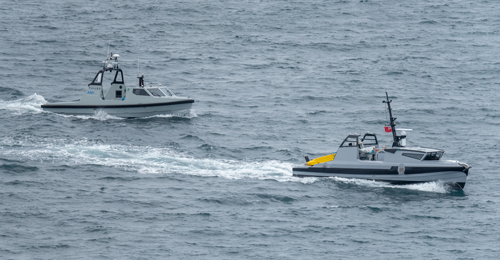Digital Trust at Sea
That was then. This is now.
How the Royal Navy, and others, are embarking on a voyage of digital transformation
Take a look around. We live in a world of technological sophistication that was all but unimaginable ten years ago. And we’ve only just started. Today we stand at the threshold of what many are calling the fourth industrial revolution: an age of unmanned autonomous vehicles, artificial intelligence and big data analytics.
But how did we get here? And who are the movers and shakers who are shaping our world of the future?

In the past it was the defence industry which drove technological development, with the commercial world adopting and adapting it some years later. Digital cameras, microwave ovens, duct tape, synthetic rubber, superglue and tinned food all have military origins.
Today, however, the baton of technology has been passed to the commercial world. Now it is the military who must adopt and adapt. And that presents the Royal Navy and other naval forces with some new challenges, not least of which is evaluating technology partners.
A world apart
Large commercial and public sector organisations are used to information on demand, delivered through superfast broadband. And now they are striving for digital transformation – the state in which an organisation is fully connected and where information flows like a river rather than residing in puddles.
Even on land that’s no small undertaking. But on a warship, at sea, it’s a daunting challenge. Or rather, a set of challenges.
The first task is concerned with infrastructure. Modern warships host a bewildering array of systems: power and propulsion; engineering operations; helm and navigation controls; combat systems; threat detection; command and control systems, communications; electronic warfare; damage control, and a great deal else besides.

What’s more, for maximum survivability in times of conflict, these systems incorporate redundancy and are segregated from other control functions. The result is dozens of isolated networks and hundreds of servers, of varying age and provenance, acquired over a series of upgrades and refits.
On land, an obvious first step to simplifying and unifying this clutter of systems would be to start from scratch, ripping out the old the networks and replacing them with a single, very fast network with multitasking workstations.
Thales and other defence contractors have already worked on designs for ship-wide shared infrastructures for data and communications. But that’s just the first and the easiest part of the solution.
The real challenge is not moving data but making it work for you.
Bringing trust to digital transformation
Let’s take a broader look at how other industries are approaching digital transformation and see if the lessons learned there might also apply to a naval environment.

The automotive industry is perhaps the most active sector. Modern vehicles already have hundreds if not thousands of sensors, which not only keep the car running smoothly and the driver informed of how it is performing, but which can also feed diagnostic and performance data back to the manufacturer.
Some of the luxury marques are now exploring ways to fully connect, enhancing the ownership experience by performing automatic software updates over Wi-Fi to fix problems, add new features and otherwise engage more closely with the driver. But there are risks.
It is a matter of record that hackers have been able to take control over a car’s brakes and steering from a distance of 12 miles. That’s frightening enough in a car. But how about a warship under attack from a sophisticated cyber enemy? What then?
The benefits of sharing
Modern technology can provide almost unimaginable amounts of data – far too much for the human mind to make sense of. As well as thousands of internal sensors, a warship has various types of radar, sonar and weapons systems. It captures information from these, from other ships and from aircraft, from satellite communications, and from land bases. Plus, of course, we live in – or at least aspire to - a world of ‘information-on-demand’ and ‘everything-over-IP’.
With the right approach, a warship has the potential to capture, store, analyse, share and exploit huge amounts of information. For the Navy, digital transformation really could be a game changer.
Let’s take a look at radar, for instance. Echoes from rain and other precipitation, flocks of birds, auroras, and atmospheric density can all affect its performance. Perhaps, with the help of big data analytics, we could analyse historical data, find subtle and complex patterns which the human eye would never detect, and use this real-life information to improve performance in adverse conditions.
A matter of trust
Although it’s somewhere to start, a shared infrastructure says nothing about the security that is needed before information can be relied upon. And on a warship, only military-grade security will do.
Consider external communications. Perhaps we want to share real time threat information with allied ships. Can that data (or our identity) be spoofed? Can our allies trust it? Can we trust their data and their identities?
Unmanned boats and submarines are close to entering service with the Royal Navy. Can they be trusted? Or can they be compromised by an unsecured, overlooked system or component, in an attack similar to that in which a car was hacked through a humble tyre pressure sensor?
The single most important issue in any digital transformation project is digital trust.
- Can you trust that the information is accurate?
- Can you trust that the information is complete?
- Can you trust the identity of the sender?
- Can you trust that the method of communication is secure?
Trust, at this level, is a function of hard proof rather than optimistic belief. If you’re going to share data, or access it remotely, cut it and dice it, or import and export it from system to system, you need impeccable, verifiable, 360-degree security. If you have that, you can trust the data. And with sufficient trusted data you can achieve anything.
Choosing the team
Although the Royal Navy is unique, it does share some of the same challenges as other organisations when it comes to embarking on a journey of digital transformation. The fact is, the science of digital transformation is in its infancy. We all have a destination in mind and everyone wants to get there, but very few people know how. You need an experienced navigator.
Much of the technology exists. Public key encryption has been with us for decades. Blockchain is at least ten years old. Hardware security modules that are impervious to all attempts at data theft have been with us for years. Identity warrants can give every connectable device a unique and unalterable cryptographic identity.
So who do you look for? A partner who understands ships? A firm of IT security consultants? A systems integrator? A defence contractor?
In an ideal world, you need everything. The Royal Navy’s journey (and your own journey) to digital transformation will be unique. It will be neither short nor quick and, at this moment, there is no map. But you have to get there safely.
Of course you need a partner who understands large-scale systems integration and knows how to adapt, implement and support technology. And you need a partner who has an intimate knowledge of your particular industry, a partner who understands your specific operational technology.
But, most of all, you need - you most definitely need - a partner who is on the leading edge of everything that is digital transformation - a partner who understands the real meaning of digital trust.